|
|
| Line 106: |
Line 106: |
| | | | |
| | Such assessments of identity cannot be made on the basis of a metadata standard alone. | | Such assessments of identity cannot be made on the basis of a metadata standard alone. |
| | + | |} |
| | + | |
| | + | {| style="float: right; border: 1px solid #BBB; margin: .46em 0 0 .2em;" |
| | + | |- |
| | + | | width="810px" style="background-color:#F0F0F0" | |
| | + | References and Materials: Identity and identifiers |
| | + | * [http://www.athenaeurope.org/getFile.php?id=779 Persistent Identifiers (PIDs): Recommendations for Institutions.] <i>- A useful guideline from the ATHENA project, April 2011</i> |
| | |} | | |} |
| | | | |
Revision as of 14:54, 13 May 2011
From the TC 372 Workshop Compendium
Where philosophers can help
Any statement about something must identify the thing in question. Introducing description levels into metadata also means introducing different concepts of identity.
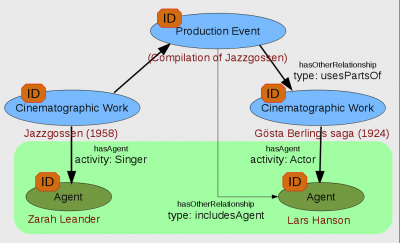
Graph based on information from the Swedish Film Database
|
In the relationship graph from the preceding session we identified instances of Cinematographic Work by a title, and instances of Agent by a name.
As databases grow, titles and names can quickly become ambiguous, while machines require unambiguous indentifiers for operating on relationships. Moreover, in this example we have an instance of an Event entity, for which no "natural" identifier exists.
|

From: Internet Movie Database, http://www.imdb.com/ accessed 13-Oct-2010
|
For many years, the creators of the Internet Movie Database (and also those of Wikipedia) believed that all things of interest could be identified uniquely and persistently by a name, a title, or similar.
This identifier scheme turned out to be difficult to manage as the databases grew in size.
In recent years, both databases have introduced non-semantic identifiers in the form of numbering schemes that remain hidden from the user interface.
|
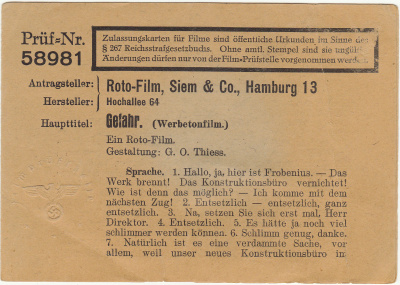
|
No bureaucracy without identifiers.
An identifier such as "58981" can only be unique within a particular scope, in this case, the set of German film censorship records.
In databases, the scope of an identifier is usually limited to an entity from the data model. In this way, different entities can share the same set of identifiers, e.g. a Cinematographic Work 12345 can be distinguished from an Agent 12345.
In the Linked Open Data paradigm, the scope of an identifier is determined by a namespace. All UniformResource Identifiers (URIs) must contain a component that identifies a namespace.
|
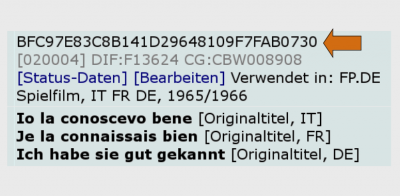
From the in-house database of Deutsches Filminstitut, Frankfurt am Main
|
This is an identifier from the DIF database which uses globally unique identifiers (GUIDs) for all instances of all entities.
GUIDs are numbers with 128 binary places (38 decimal places) which are constructed in such a way that the chance of two computers generating the same ID is extremely small, even over long periods of time.
GUIDs are particularly useful in environments where data is created without centralised control.
|
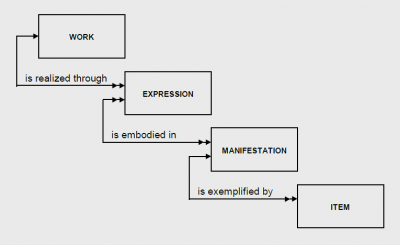
From: Functional Requirements for Bibliographic Records. IFLA UBCIM Publications – New Series Vol 19. München: K.G. Saur, 1998
|
Identity (expressed through identifiers) plays a major role in interpreting the FRBR description layers.
Two items can only share an identity at the manifestation level. Likewise, two manifestations can only share an identical expression, etc.
Levels or modes of identity have been (and continue to be) a major topic of analytical philosophy.
|

Photos and montage: Detlev Balzer, 2010
|
Levels of identity can be distinguished in every kitchen.
On the left, we have an item which, by definition, can only be identical with itself. In the center, we have two items that are identical at the manifestation level, i.e. these forks were apparently manufactured from the same mould. On the right we have two items from different manifestations that are identical at a generic concept level, i.e. both can be identified as forks.
We could easily extend this example with a fourth level, e.g. pieces of cutlery belonging to a named series from a particular designer.
|
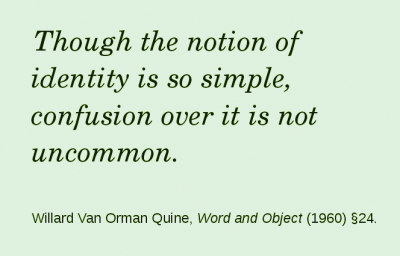
|
Questions of identity have often been the subject of drama, one of the best known examples being Dr. Jekyll and Mr. Hyde.
In the context of filmography, similar questions arise when film works are modified to an extent that the level of identity needs to be assessed.
Such assessments of identity cannot be made on the basis of a metadata standard alone.
|
|
References and Materials: Identity and identifiers
|






